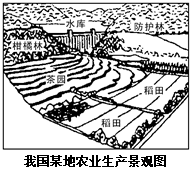问题
选择题
读我国某地农业生产景观图,判断该地位于

A.黄土高原
B.山东丘陵
C.江南丘陵
D.东北平原
答案
答案:C
题目分析:从图中可以看出,该地种植水稻、柑橘,并且该地修建梯田,坡度较大,结合选项可知,该地最可能是江南丘陵,故选C项。
读我国某地农业生产景观图,判断该地位于

A.黄土高原
B.山东丘陵
C.江南丘陵
D.东北平原
答案:C
题目分析:从图中可以看出,该地种植水稻、柑橘,并且该地修建梯田,坡度较大,结合选项可知,该地最可能是江南丘陵,故选C项。